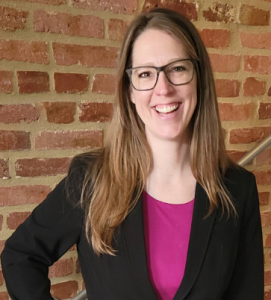By Adam Stone

Andrew Loewen sees a fundamental problem with the way the law works.
Simply put, “the legal system is not delivering justice for most real people,” says Loewen, J.D. ’22. “People can’t afford the lawyers they need. They don’t know how the law works. The legal system favors those with the right background, the right connections, and bigger bankrolls for endless litigation.”
To raise awareness, Loewen founded the UBalt Law chapter of the People’s Parity Project (PPP), a national organization that describes itself as seeking to “unrig the legal system and build a justice system that values people over profits.”
What makes justice inaccessible? It’s not just the cost of going to court. “One thing PPP has highlighted is the fact that people are locked out of courts in the first place, because they sign away their rights through contracts that come with arbitration agreements,” says Loewen, who is currently a legal fellow with the Public Rights Project. Consumers and employees alike find, too late, that such contracts work against them.

As incoming president of the UBalt group, Melissa Murphy, J.D. ’24, is in the midst of a two-year PPP fellowship. She’s looking at state courts, “how judges get to the bench, what their professional background is, what their racial background is, their social-economic background,” she says. “Are those decision-makers actually reflecting the population that they’re serving? And if they’re not, how can we make those changes?”
Murphy worked previously as a paralegal in the nonprofit world, supporting survivors of domestic violence and sexual assault who couldn’t navigate the law on their own. Then she went to a private firm, “and I saw firsthand how expensive it is to have somebody with a legal background to guide you through the system,” she says.
“I wanted see how we could bridge the gap, so that that you don’t need a ton of money in order to get access,” she says. And law school seems to her like the right place to have those kinds of conversations.
PPP on campus “is making connections with the different student groups,” Murphy says. Environmental law issues for example have a parity component, as do workforce and housing law. “We trying to make the connections so that we are all working towards similar goals.”

UBalt PPP immediate past president Laura Grant, J.D. ’23, worked for an employment law firm before coming to law school. “I saw how the corporate world tends to take advantage of low wage people through these complicated legal restrictions,” she says. “Employment contracts, nondisclosure agreements, non-compete agreements all had a real effect on people.”
When students are learning the law, “that’s the perfect time to instill the kinds of values that People’s Parity Project has,” she says.
With PPP helping to bring parity to the fore, “students can be thinking about increasing access to justice, while they’re actually studying the law,” she says. “They can talk about these things in class. And when they’ve graduated, they are already thinking: OK, what can I do to make things better?”
Grant said that newly minted lawyers have a special obligation to think about issues of fairness and equity, and that doing so will make them better at their jobs.
“We’re expected to guide our clients through some of the most stressful times in their lives,” she says. “I have that credibility, and it’s important to use for the benefit of people who don’t have it. Recognizing that I’m in this position to help people have access: that makes me a better lawyer.”
Through its PPP chapter, Loewen says, UBalt Law can help the legal profession make incremental progress on these complex issues.
“People don’t necessarily go to law school so they can change the world,” he says. “But we can shine light on the power that people do have, and the impact that they could have.”
Adam Stone is a writer based in Annapolis.
